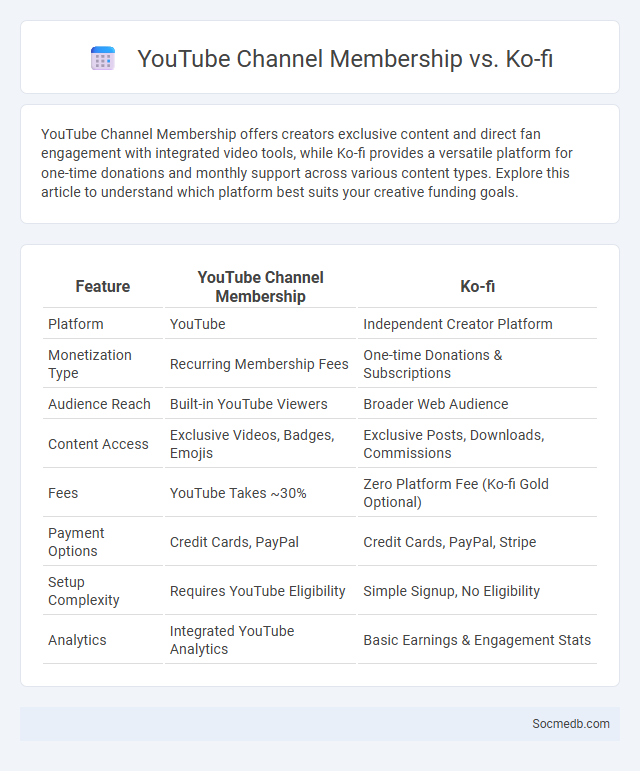
Photo illustration: YouTube Channel Membership vs Ko-fi
YouTube Channel Membership offers creators exclusive content and direct fan engagement with integrated video tools, while Ko-fi provides a versatile platform for one-time donations and monthly support across various content types. Explore this article to understand which platform best suits your creative funding goals.
Table of Comparison
| Feature | YouTube Channel Membership | Ko-fi |
|---|---|---|
| Platform | YouTube | Independent Creator Platform |
| Monetization Type | Recurring Membership Fees | One-time Donations & Subscriptions |
| Audience Reach | Built-in YouTube Viewers | Broader Web Audience |
| Content Access | Exclusive Videos, Badges, Emojis | Exclusive Posts, Downloads, Commissions |
| Fees | YouTube Takes ~30% | Zero Platform Fee (Ko-fi Gold Optional) |
| Payment Options | Credit Cards, PayPal | Credit Cards, PayPal, Stripe |
| Setup Complexity | Requires YouTube Eligibility | Simple Signup, No Eligibility |
| Analytics | Integrated YouTube Analytics | Basic Earnings & Engagement Stats |
Understanding YouTube Channel Membership
YouTube Channel Membership offers exclusive benefits such as custom badges, emojis, and members-only content to engage your audience and monetize your channel effectively. Subscribers pay a recurring monthly fee, providing creators with a steady revenue stream while fostering a loyal community. By understanding these features, you can tailor your content to meet Your members' preferences and enhance viewer interaction.
What is Ko-fi and How Does it Work?
Ko-fi is a digital platform that enables creators to receive financial support directly from their audience through one-time donations or monthly memberships. Users can set up personalized pages where supporters contribute via "buying a coffee," symbolizing small donations, without platform fees on basic plans. Ko-fi also integrates with content creation tools and offers features like exclusive content, commissions, and shop options to enhance creator-fan interaction and monetization.
Comparing Monetization Features
Social media platforms like Facebook, Instagram, YouTube, and TikTok each offer distinct monetization features tailored to content creators. YouTube primarily generates revenue through ad revenue sharing and channel memberships, while Instagram leverages sponsored posts and shopping integrations for influencer earnings. TikTok emphasizes creator fund payouts and live gifts, whereas Facebook combines ad breaks with fan subscriptions and branded content tools to maximize creator income.
Membership Pricing and Revenue Split
Social media platforms often implement tiered membership pricing models, offering basic access for free while charging for premium features such as ad-free experiences, advanced analytics, or exclusive content. Revenue splits typically favor the platform, with creators receiving a percentage ranging from 30% to 70% depending on the service and membership level. This pricing strategy balances user acquisition with monetization, driving sustained revenue growth through diverse membership plans and strategic revenue-sharing agreements.
Platform Accessibility for Creators and Fans
Platform accessibility for creators and fans has become a driving force in social media growth, enabling seamless content creation and consumption across diverse devices and user abilities. Features like voice commands, screen readers, and customizable interfaces enhance user experience, while algorithm transparency ensures fair content distribution. You benefit from inclusive design that bridges gaps between creators and audiences, fostering vibrant, interactive communities.
Customization and Member Perks
Social media platforms offer extensive customization options that allow users to tailor their profiles, content preferences, and notification settings to enhance user experience. Many platforms provide exclusive member perks, such as early access to new features, special badges, or premium content, increasing user engagement and loyalty. Personalized algorithms combined with member perks create a more interactive and rewarding environment for active users.
Payment and Withdrawal Options
Social media platforms increasingly offer diverse payment and withdrawal options to enhance user convenience and security. Your ability to link multiple payment methods, including credit cards, digital wallets, and bank transfers, streamlines transactions for ads, subscriptions, and e-commerce activities. Secure withdrawal options ensure timely access to your earnings from content monetization, influencer partnerships, and in-app sales.
Audience Engagement Tools
Audience engagement tools on social media platforms include polls, live videos, and interactive stories that encourage real-time participation and feedback. Features such as comment sections, reaction buttons, and direct messaging facilitate deeper connections between brands and users. Analytics dashboards track engagement metrics like likes, shares, and comments, enabling marketers to refine content strategies for maximum user interaction.
Brand and Content Control
Brands maintain control over social media content by strategically managing their messaging and visual identity to ensure consistent representation across platforms. Utilizing analytics tools empowers brands to monitor audience engagement and adjust content for maximum impact and relevance. Effective brand and content control strengthens customer trust, enhances brand loyalty, and drives targeted marketing success.
Choosing the Best Platform for Your Needs
Selecting the best social media platform for your needs depends on your target audience, content type, and goals. Platforms like Instagram and TikTok excel in visual storytelling, while LinkedIn is ideal for professional networking and B2B marketing. Understanding your audience's preferences helps you maximize engagement and reach.
 socmedb.com
socmedb.com